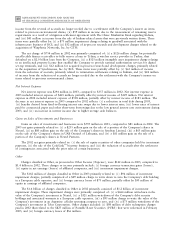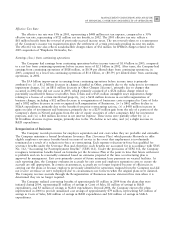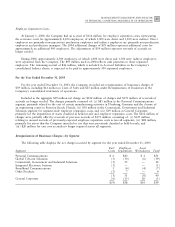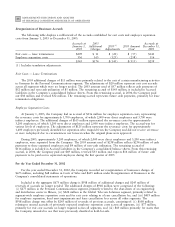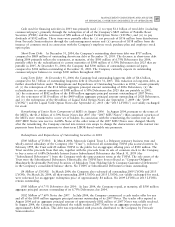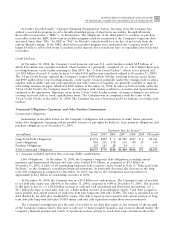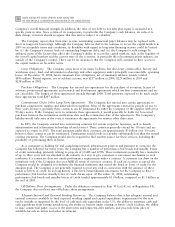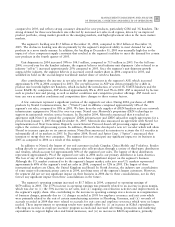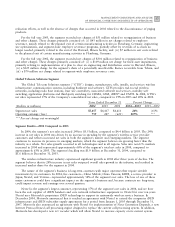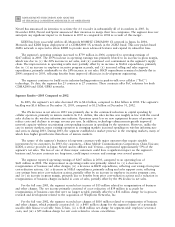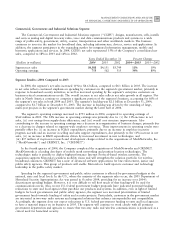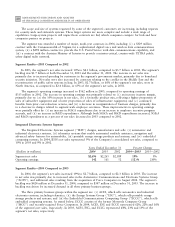Motorola 2004 Annual Report Download - page 58
Download and view the complete annual report
Please find page 58 of the 2004 Motorola annual report below. You can navigate through the pages in the report by either clicking on the pages listed below, or by using the keyword search tool below to find specific information within the annual report.
50 MANAGEMENT'S DISCUSSION AND ANALYSIS
OF FINANCIAL CONDITION AND RESULTS OF OPERATIONS
$1.4 Billion of 6.75% Debentures due 2006: In July 2004, the Company called for the redemption of all
$1.4 billion aggregate principal amount outstanding of its 2006 Debentures. All of the 2006 Debentures were
redeemed in August 2004 for an aggregate purchase price of approximately $1.5 billion. This debt was redeemed
partially with proceeds distributed to the Company by Freescale Semiconductor and partially with available cash
balances.
$110 Million of 6.50% Debentures due 2028: In August 2004, the Company completed the open market
purchase of $110 million of the $409 million aggregate principal amount outstanding of its 2028 Debentures. The
$110 million principal amount of 2028 Debentures was purchased for an aggregate purchase price of approximately
$115 million.
Given the Company's cash position, it may from time to time seek to opportunistically retire certain of its
outstanding debt through open market cash purchases, privately-negotiated transactions or otherwise. Such
repurchases, if any, will depend on prevailing market conditions, the Company's liquidity requirements, contractual
restrictions and other factors.
$1.2 Billion of Proceeds from the Sale of Stock Pursuant to Equity Security Units During 2004: The
Company sold $1.2 billion of MEUs during the fourth quarter of 2001. In November 2004, pursuant to the terms
of the MEUs the Company sold 69.4 million shares of common stock for $1.2 billion to the holders of the MEUs.
Pursuant to the terms of the MEUs, the price per share paid by the holders of the MEUs was based on the
applicable market value of the Company's common stock at the purchase date. The purchase price was $17.30 per
share, resulting in the holders purchasing 2.8902 shares of common stock per MEU, for a total of 69.4 million
shares.
Credit Ratings: Three independent credit rating agencies, Standard & Poor's (""S&P''), Moody's Investor
Services (""Moody's'') and Fitch Investors Service (""Fitch''), assign ratings to the Company's short-term and long-
term debt.
The following chart reÖects the current ratings assigned to the Company's senior unsecured non-credit
enhanced long-term debt and the Company's commercial paper by each of these agencies:
Long-Term Debt Commercial Date of Last
Name of Rating Agency Rating Outlook Paper Action
S&P BBB positive A-2 August 2, 2004
Moody's Baa3 positive P-3 July 21, 2004
Fitch BBB° positive F-2 January 20, 2005
In January 2005, Fitch upgraded the Company's long-term debt rating to ""BBB°'' with a ""positive'' outlook
from ""BBB'' with a ""positive'' outlook. There was no change in the short-term rating of ""F-2''. In August 2004
S&P changed its outlook on the Company's long-term debt to ""BBB'' with a ""positive'' outlook from ""BBB'' with
a ""negative'' outlook. There was no change in the short-term rating of ""A-2.'' In July 2004, Moody's changed its
outlook on the Company's long-term debt to ""Baa3'' with a ""positive'' outlook from ""Baa3'' with a ""negative''
outlook. There was no change in the short-term rating of ""P-3.''
The Company's debt ratings are considered ""investment grade.'' If the Company's senior long-term debt were
rated lower than ""BBB-'' by S&P or Fitch or ""Baa3'' by Moody's (which would be a decline of one level from
current Moody's ratings), the Company's long-term debt would no longer be considered ""investment grade.'' If this
were to occur, the terms on which the Company could borrow money would become more onerous. The Company
would also have to pay higher fees related to its domestic revolving credit facility. The Company has never
borrowed under its domestic revolving credit facilities.
The Company continues to have access to the commercial paper and long-term debt markets. However, the
Company generally has had to pay a higher interest rate to borrow money than it would have if its credit ratings
were higher. The Company has greatly reduced the amount of its commercial paper outstanding in comparison to
historical levels and has maintained commercial paper balances of between $300 million and $500 million for the
last 4 years. This reÖects the fact that the market for commercial paper rated ""A-2/P-3/F-2'' is much smaller than
that for commercial paper rated ""A-1/P-1/F-1'' and commercial paper or other short-term borrowings may be of
limited availability to participants in the ""A-2/P-3/F-2'' market from time-to-time or for extended periods.


